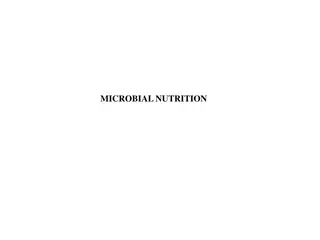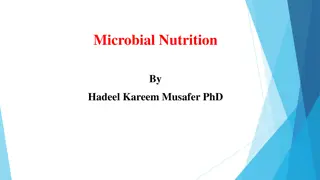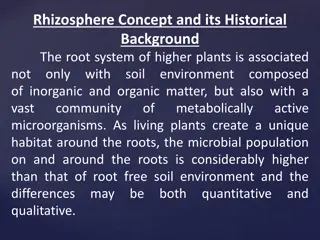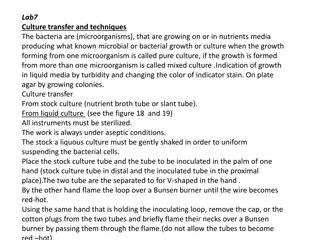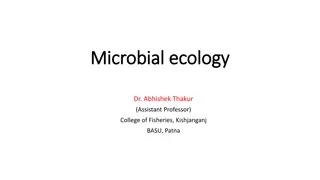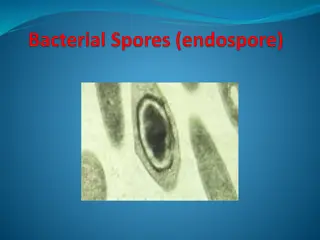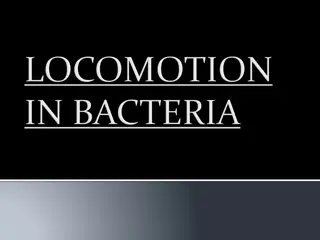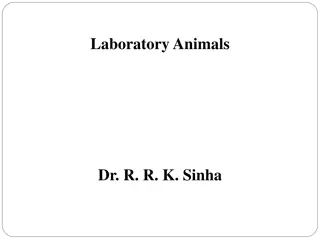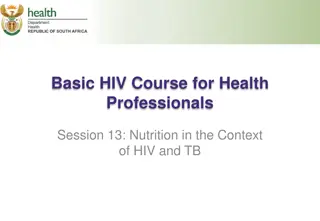Understanding Microbial Nutrition and Bacterial Physiology
Microbial nutrition involves essential elements required for microbial growth and energy production. Bacterial physiology delves into the structures and functions that enable bacteria to thrive, from cell wall composition to enzyme activities. Major elements like C, O, H, N, S, and P are crucial for constructing cellular components, while macroelements like K, Ca, Mg, and Fe play specific roles in enzyme activity and cell stability.
Download Presentation

Please find below an Image/Link to download the presentation.
The content on the website is provided AS IS for your information and personal use only. It may not be sold, licensed, or shared on other websites without obtaining consent from the author. Download presentation by click this link. If you encounter any issues during the download, it is possible that the publisher has removed the file from their server.
E N D
Presentation Transcript
Microbial Nutrition Lec.1
Introduction to Bacterial physiology Bacterial physiology is the study of the structures and functions that allow bacteria to survive. This includes everything from the composition of bacterial cell walls to the enzymes they can produce to perform various internal and external functions.
Microbial Nutrition Microorganisms requires about 10 elements in large quantities, used to construct carbohydrates, lipids, proteins and nucleic acids. Several other factors are needed in very small amounts and are parts of enzymes and cofactors.
To obtain energy and construct new cellular components, organisms must have a supply of raw materials or nutrients. Nutrients are substances used in biosynthesis and energy release and therefore are required for microbial growth.
Analysis of microbial cell composition shows that over 95% of cell dry weight is made up of a few major elements; Carbon, Oxygen, Hydrogen, Nitrogen, Sulfur, Phosphorus, Potassium, Calcium, Magnesium and Iron which are called macro- elements or macronutrients because they are required by microorganisms in relatively large amounts.
First six (C,O,H,N,S and P) are components of carbohydrates, lipids, proteins and nucleic acids while the remaining four macroelements exist in the cell as cations and play a variety of roles; potassium (K+) is required for activity by number of enzymes, including some of those involved in protein synthesis.
Calcium (Ca+2) contributes to the heat resistance of bacterial endospores. Magnesium (Mg+2) serves as a cofactor for many enzymes, complexes with ATP and stabilizes ribosomes and cell membranes. Iron (Fe+2 and Fe+3) is a part of cytochromes and a cofactor for enzymes and electron carrying proteins.
All organisms including microorganisms (M.O) needs several micronutrients or trace elements; manganese, zinc, cobalt, molybdenum, nickel and copper. They are a part of enzymes and cofactors and they aids in the catalysis of reactions and maintenance of protein structure. Zinc (Zn) is present at the active site of some enzymes.
Requirements for Carbon, Hydrogen and Oxygen Carbon requirements considers as a skeleton or backbone of all organic molecules. Molecules serving as carbon sources also contribute both oxygen and hydrogen atoms. M.O also needs a source of electron. The electron movement through electron transport chains and during other oxidation-reduction reactions can provides energy which can use in microbial activities.
Electron also requires in the reduction reactions during biosynthesis. Carbon dioxide (CO2) does not supply hydrogen or energy for the cell. All M.O can fix (CO2) and reduce it to form organic molecules.
Nutritional types of microorganisms M.O can be classified into nutritional classes based on how they satisfy all their requirements (C, H, O, energy and electrons). There are two sources of energy available to M.O:
Light energy & Energy derived from oxidizing organic or inorganic molecules. 1. Phototrophs: M.O that use light as their energy source. 2. Chemotrophs: M.O obtain energy from the oxidation of chemical compounds (organic & inorganic molecules).
Classification of M.O according to their source of electrons 1- Lithotrophs: reduced inorganic substances as their electron source. 2-Organotrophs: extract electrons from organic compounds. According to carbon sources, M.O can be divided into two groups 1-Autotrophs; CO2 sole or principal biosynthetic carbon source. 2-Heterotrophs; Reduced, preformed, organic molecules are their carbon sources.
Major Nutritional Types Most M.O may be placed in one of four nutritional classes based on their primary sources of carbon, energy, and electrons: 1-Photolithoautotrophy: L/E; Inorganic H/Electron donor; CO2 2-Photoorganoheterotrophy: L/E; Organic H/Electron donor; O/ C source
3-Chemolithoautotrophy: CH/E Inorganic; Inorganic H/Electron donor; CO2 4-Chemoorganoheterotrophy: CH /E Organic; Organic H/Electron donor; O/ C source. Mixotrophic: M.O that combine ch.li.au. tr. & heterotrophic metabolic processes.
Requirements for Nitrogen, Phosphorus and Sulfur M.O must be able to incorporate large quantities of N, P & S in order to growth. Nitrogen requires for synthesis of amino acids, purines, pyrimidines, some carbohydrates, lipids, enzyme cofactors and other substances.
Phosphorus is present in nucleic acids, phospholipids, nucleotides like ATP, several cofactors, some proteins and other cell components. All M.O use inorganic phosphate as their phosphorus source. Sulfur is needed for the synthesis of some amino acids like cysteine, methionine, some carbohydrates, biotin and thiamine. Most M.O use sulphate as a source of sulfur and reduce it by assimilatory sulfate reduction.
Growth factors: are an essential organic compounds required which are unable to synthesize by the organism. There are three major classes of growth factors: 1.Amino acids: require for protein synthesis. 2.Purines and pyrimidines: requires for nucleic acid synthesis. 3.Vitamins: small organic molecules that make up all or part of enzyme cofactors, only very small amounts sustain growth. Most common vitamins are Biotin, Folic acid and Riboflavin (B2).
References References 1. Microbial Physiology. Albert G Moat, John W Foster, Michael P. Spector. 2002. Fourth Edition. A John Wiley and sons, INC., publication. 2. Microbiology. Lansing M Prescott, John P. Harley, Donald A. Klein.2004. Sixth Edition. Higher Education. 3. Microbial an introduction. 2004. Gerard J Tortora, Berdell R Funke, Christine L Case. Eighth Edition.




